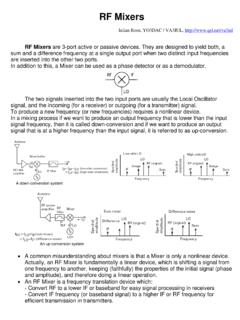Transcription of Image Super-Resolution via Deep Recursive Residual Network
1 Image Super-Resolution via Deep Recursive Residual Network Ying Tai 1 , Jian Yang1 , and Xiaoming Liu2. 1. Department of Computer Science and Engineering, Nanjing University of Science and Technology 2. Department of Computer Science and Engineering, Michigan State University {taiying, Abstract DRRN_B1U25. DRRN_B1U9. Recently, Convolutional Neural Network (CNN) based DRCN RED30. models have achieved great success in single Image super - VDSR. Resolution (SISR). Owing to the strength of deep networks, these CNN models learn an effective nonlinear mapping from the low-resolution input Image to the high-resolution CSCN. target Image , at the cost of requiring enormous parameters. ESPCN. This paper proposes a very deep CNN model (up to 52 con- volutional layers) named Deep Recursive Residual Network SRCNN. (DRRN) that strives for deep yet concise networks. Specifi- cally, Residual learning is adopted, both in global and local manners, to mitigate the difficulty of training very deep net- Figure 1.}
2 PSNR of recent CNN models for scale factor 3 on works; Recursive learning is used to control the model pa- Set5 [1]. Red points are our models. , , and are models with rameters while increasing the depth. Extensive benchmark less than 5 layers, 20 layers, and more than 30 layers, respectively. evaluation shows that DRRN significantly outperforms state DRRN B1U9 means there is 1 Recursive block, in which 9 Residual of the art in SISR, while utilizing far fewer parameters. units are stacked. With the same depth but far fewer parameters, Code is available at DRRN B1U9 achieves better performance than the state-of-the- /DRRN CVPR17. art methods [13,14]. After increasing the depth without adding any parameters, the 52-layer DRRN B1U25 further improves the per- formance and significantly outperforms VDSR [13], DRCN [14]. and RED30 [17] by , and dB respectively. 1. Introduction single Image Super-Resolution (SISR) is a classic com- posed inverse problem of super Resolution (SR), and have puter vision problem, which aims to recover a high- demonstrated superiority over reconstruction-based meth- resolution (HR) Image from a low-resolution (LR) Image .
3 Ods [4, 35] or other learning paradigms [20, 22, 23, 31]. As Since SISR restores the high-frequency information, it is the pioneer CNN model for SR, Super-Resolution Convo- widely used in applications such as medical imaging [26], lutional Neural Network (SRCNN) [2] predicts the nonlin- satellite imaging [29], security and surveillance [37], where ear LR-HR mapping via a fully convolutional Network , and high-frequency details are greatly desired. significantly outperforms classical non-DL methods. How- In recent years, due to the powerful learning ability, ever, SRCNN does not consider any self similarity prop- Deep Learning (DL) models, especially Convolutional Neu- erty. To address this issue, the Deep Joint super Resolution ral Networks (CNN), are widely used to address the ill- (DJSR) jointly utilizes both the wealth of external examples and the power of self examples unique to the input.
4 Inspired This work was conducted when the first author was a visiting scholar by the learning iterative shrinkage and thresholding algo- at Michigan State University. It was supported by the National Sci- rithm [5], Cascaded Sparse Coding Network (CSCN) [32]. ence Fund of China under Grant Nos. 91420201, 61472187, 61502235, is trained end-to-end to fully exploit the natural sparsity of 61233011, 61373063 and 61602244, the 973 Program , Program for Changjiang Scholars and Innovative Research Team in Uni- images. Shi et al. [25] observe that the prior models [2, 32]. versity, and partially sponsored by CCF-Tencent Open Research Fund. increase LR Image 's resolution via bicubic interpolation be- 13147. fore CNN learning, which increases the computational cost. ficulty of training deep networks. Therefore, we also adopt The Efficient Sub-Pixel Convolutional neural Network (ES- GRL in our identity branch.)
5 Further, very deep networks PCN) reduces the computational and memory complexity, could suffer from the performance degradation problem, by increasing the resolution from LR to HR only at the end as observed in visual recognition [8] and Image restora- of the Network . tion [17]. The reason may be a significant amount of Image One commonality among the above CNN models is that details are lost after so many layers. To address this issue, their networks contain fewer than 5 layers, , SRCNN [2] we introduce an enhanced Residual unit structure, termed uses 3 convolutional layers. Their deeper structures with 4 as multi-path mode Local Residual Learning (LRL), where or 5 layers do not achieve better performance, which was the identity branch not only carries rich Image details to late attributed to the difficulty of training deeper networks and layers, but also helps gradient flow. GRL and LRL mainly led to the observation that the deeper the better might not differ in that LRL is performed in every few stacked lay- be the case in SR.
6 Inspired by the success of very deep net- ers, while GRL is performed between the input and output works [8, 27, 28] on ImageNet [21], Kim et al. [13, 14] pro- images, , DRRN has many LRLs and only 1 GRL. pose two very deep convolutional networks for SR, both (2) Recursive learning of Residual units is proposed in stacking 20 convolutional layers, from the viewpoints of DRRN to keep our model compact. In DRCN [14], a training efficiency and storage, respectively. On the one deep Recursive layer (up to 16 convolutional recursions). hand, to accelerate the convergence speed of very deep net- is learned and the weights are shared in the 16 convolu- works, the VDSR [13] is trained with a very high learning tional recursions. Our DRRN has two major differences rate (10 1 , instead of 10 4 in SRCNN) and the authors fur- compared to DRCN: (a) Unlike DRCN that shares weights ther use Residual learning and adjustable gradient clipping among convolutional layers, DRRN has a Recursive block to solve gradient explosion problem.
7 On the other hand, to consisting of several Residual units, and the weight set is control the model parameters, the Deeply- Recursive Con- shared among these Residual units. (b) To address the van- volutional Network (DRCN) [14] introduces a very deep re- ishing/exploding gradients problem of very deep models, cursive layer via a chain structure with up to 16 recursions. DRCN supervises every recursion so that the supervision To mitigate the difficulty of training DRCN, the authors use on early recursions help backpropagation. DRRN is re- Recursive -supervision and skip-connection, and adopt an en- lieved from this burden by designing a Recursive block with semble strategy to further improve the performance. Very a multi-path structure. Our model can be easily trained even recently, Mao et al. [17] propose a 30-layer convolutional with 52 convolutional layers. Last but not least, through re- auto-encoder Network named RED30 for Image restoration, cursive learning, DRRN can improve accuracy by increas- which uses symmetric skip connections to help training.
8 All ing depth without adding any weight parameters. of the three models learn the Residual Image between the in- To illustrate the effectiveness of the two strategies used put Interpolated LR (ILR) Image and the ground truth HR in DRRN, Fig. 1 shows the Peak Signal-to-Noise Ratio Image in the Residual branch. The Residual Image is then (PSNR) performance of several recent CNN models for added to the ILR Image from the identity branch to esti- SR [2, 13, 14, 17, 25, 32] versus the number of parameters, mate the HR Image . The three models outperform the pre- denoted as k. Compared to the prior CNN models, DRRN. vious DL and non-DL methods by a large margin, which achieves the best performance with fewer parameters. demonstrates the deeper the better is still true in SR. Despite achieving excellent performance, the very deep 2. Related Work networks require enormous parameters. Compared to the Since Sec.
9 1 overviews DL-based SISR, this section fo- compact models, large models demand more storage space cuses on three most related work to ours: ResNet [8], and are less applicable to mobile systems [6]. To address VDSR [13] and DRCN [14]. Fig. 2 illustrates these models this issue, we propose a novel Deep Recursive Residual via simplified Network structures with only 6 convolutional Network (DRRN) to effectively build a very deep Network layers, where the activation functions, batch normalization structure, which achieves better performance, but with 2 , (BN) [11] and ReLU [19], are omitted for clarity. 6 , and 14 fewer parameters than VDSR, DRCN, and RED30, respectively. In a nutshell, DRRN advances the SR ResNet performance with a deeper yet concise Network . Specifi- The main idea of ResNet [8] is to use a Residual learn- cally, DRRN has two major algorithmic novelties: ing framework to ease the training of very deep networks.
10 (1) Both global and local Residual learning are introduced Instead of hoping every few stacked layers directly fit the in DRRN. In VDSR and DRCN, the Residual Image is es- desired underlying mapping, the authors explicitly let these timated from the input and output of the networks, termed layers fit a Residual mapping, which is assumed to be easier as Global Residual Learning (GRL). Since the SR output is for optimization. Denoting the input as x and the underly- vastly similar to the input, GRL is effective in easing the dif- ing mapping as H(x), the Residual mapping is defined as 3148. Input Input Input Input conv conv conv conv conv conv conv conv conv conv conv conv . conv conv conv conv conv conv conv conv conv . conv Output 1 .. Output 4 conv w1 w4. conv . Output Output Output Output (a) ResNet (b) VDSR (c) DRCN (d) DRRN (ours). Figure 2. Simplified structures of (a) ResNet [8].
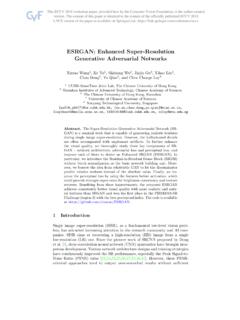
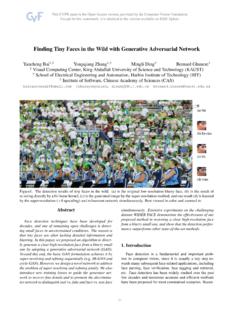

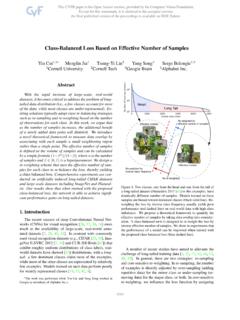
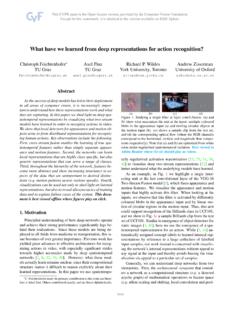
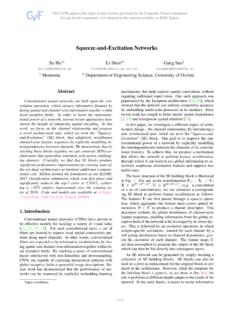
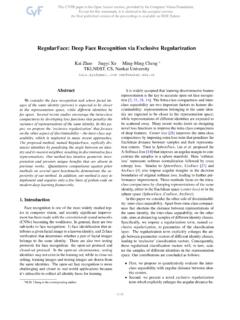
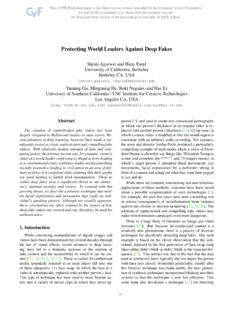
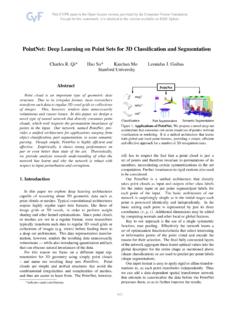
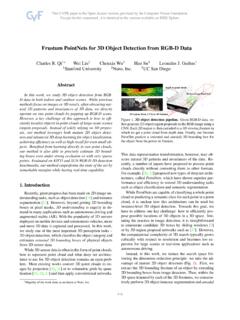

![and Super-Resolution arXiv:1603.08155v1 [cs.CV] 27 Mar 2016](/cache/preview/2/d/c/1/c/a/1/5/thumb-2dc1ca15e82fc13a292da02b4114d430.jpg)
